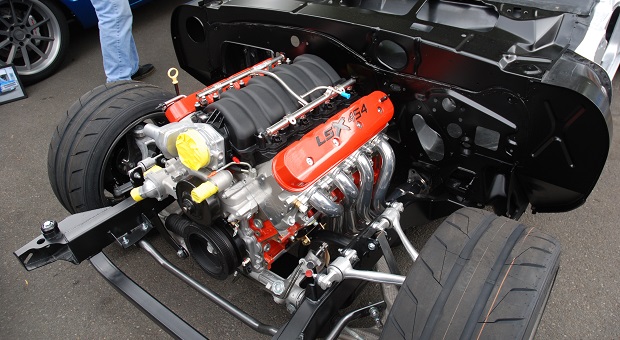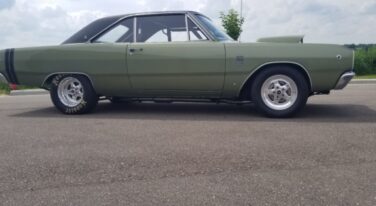
Hooker LS Swaps in '67-69 Camaro & '68-72 Nova Part 1
Click Here to Begin Slideshow
Chevy’s first generation Camaro (1967-69) and the similar 3rd gen Nova (1968-72+) have always been ripe for engine swaps. They came from the factory with small blocks, big blocks and of course straight sixes. When the LS appeared, it didn’t take long for engine swappers to do their thing. The LS is a natural in these cars. Swaps were easy enough. But since the engine never came in the car originally, there are all sorts of different ideas on where the engine should be placed. That means there are all sorts of different thoughts (and designs) for mounts and transmission cross members. Some of them mandate surgery to the car. Some do not.
One of the best-engineered mount packages is the setup offered by Hooker Headers. In a Camaro application, you can leave your cutting torch and sawzall behind when working with these components. According to Hooker Headers, Novas with a six-speed manual require some work due to a slightly different tunnel layout.
Hooker’s setup is comprehensive: They offer a motor mount package and several different cross member layouts along with headers and exhaust systems engineered to work together. Two other parts of the puzzle include a cast aluminum Holley oil pan along with a variety of engine front accessory drive configurations. Like the headers and exhaust system, the pan and the front accessory drive layouts were all designed to work in concert with each other. Basically, it’s a completely engineered swap system.
The motor mounts are specifically designed for bolt-in compatibility when used in conjunction with Hooker’s transmission cross member. Hooker’s frame mount brackets are engineered to be used in conjunction with the clamshell design rubber mounts Chevy started to use in 1972 (Camaros from ’72 to ’81 were fitted with them from the factory). Essentially, the flat Hooker adapters bolt to the sub frame, replacing the original Chevy frame motor mount brackets (or “stands”). An OEM style clamshell mount (which you’ll have to source) bolts to the flat adapter. In turn, the LS engine is fitted with Hooker’s ear-style motor mounts. The ear-style mounts engage the clamshell; they’re secured by way of a stock style long motor mount bolt.
With this setup, you’ll need to source a set of Anchor brand 2292 clamshell mounts or something similar. They’re readily available jobber components. Summit Racing sells them (currently priced at approximately $5.00 each). In addition, Hooker has recently released their own version of this clamshell mount. It’s a bit pricier than the Anchor piece and it requires the use of an aftermarket urethane insert, but the material is 50% thicker than the jobber bits. It falls under Hooker Headers part number 71221004HKR. You’ll also need to source a couple of bolts and nuts: (2) 7/16”-14 x 5-1/4” bolts and (2) 7/16-14 lock nuts. These fasteners secure the clamshell mount to the adapter. The rest of the hardware required for the install is included with the Hooker mount kit. Included is the following: (4) M10 x 1.5 lock nuts; (8) M10 x 1.5 x 30 bolts; (4) M10 x 1.5 x 25 flat head cap screws; (4) 3/8”-16 x 1” bolts (4) 3/8”-16 x 1/2” bolts; and (4) 3/8-16 lock nuts.
Hooker provides several options for the transmission too. Hooker offers cross members for 4L60 automatics, 4L80 automatics, T56 manuals and others. The setup in the photos is for a six-speed manual or a Turbo Hydramatic (400 or 2004R). In order to use the six-speed cross member with the 400 or 2004R, you’ll need a Hooker Headers adapter kit (P/N 12650HKR). Hooker tells us that 2004R installations require minor modification/welding to be done to the cross member per the instructions included with the adapter kit.
As we mentioned above, all of the Hooker swap cross members are designed as part of a complete LS swap mounting system for GM 1st-gen F-body/gen X-body vehicles. Hooker notes that it has been CAD designed and FEA validated to provide excellent structural strength and stiffness from its high-strength low-alloy steel construction. Ground clearance was maximized for routing a 2.5-inch or 3-inch exhaust system.
Hooker recommends you use an aftermarket Prothane part number 7-1604 polyurethane mount (or one of equivalent installed height), or an equivalent OEM rubber mount between the transmission and the cross member.
The kit also includes a spacer plate intended to install between the transmission isolator and transmission cross member when using a Tremec T56 Magnum aftermarket transmission. Hooker points out that leaving this spacer out will increase the engine inclination angle. That fouls the ground clearance for the exhaust and also changes the driveshaft angle.
When installed, the geometry of Hooker’s cross members along with the compatible engine mounting system align the engine crankshaft and transmission output shaft with the center line of the chassis (which is slightly different than the just-off-center stock alignment geometry used by GM). In addition, the complete package has been optimized to provide 3 to 3.5-degrees of engine/transmission inclination angle.
In the next issue, we’ll dig a bit deeper into the package. We’ll take a look at Holley’s cast aluminum LS oil pan that is engineered to work in concert with this swap. After that we'll move on to the headers, and then conclude with a look at the accessory drive system!
Chevy’s first generation Camaro (1967-69) and the similar 3rd gen Nova (1968-72+) have always been ripe for engine swaps. They came from the factory with small blocks, big blocks and of course straight sixes. When the LS appeared, it didn’t take long for engine swappers to do their thing. The LS is a natural in these cars. Swaps were easy enough. But since the engine never came in the car originally, there are all sorts of different ideas on where the engine should be placed. That means there are all sorts of different thoughts (and designs) for mounts and transmission cross members. Some of them mandate surgery to the car. Some do not.
One of the best-engineered mount packages is the setup offered by Hooker Headers. In a Camaro application, you can leave your cutting torch and sawzall behind when working with these components. According to Hooker Headers, Novas with a six-speed manual require some work due to a slightly different tunnel layout.
Hooker’s setup is comprehensive: They offer a motor mount package and several different cross member layouts along with headers and exhaust systems engineered to work together. Two other parts of the puzzle include a cast aluminum Holley oil pan along with a variety of engine front accessory drive configurations. Like the headers and exhaust system, the pan and the front accessory drive layouts were all designed to work in concert with each other. Basically, it’s a completely engineered swap system.
The motor mounts are specifically designed for bolt-in compatibility when used in conjunction with Hooker’s transmission cross member. Hooker’s frame mount brackets are engineered to be used in conjunction with the clamshell design rubber mounts Chevy started to use in 1972 (Camaros from ’72 to ’81 were fitted with them from the factory). Essentially, the flat Hooker adapters bolt to the sub frame, replacing the original Chevy frame motor mount brackets (or “stands”). An OEM style clamshell mount (which you’ll have to source) bolts to the flat adapter. In turn, the LS engine is fitted with Hooker’s ear-style motor mounts. The ear-style mounts engage the clamshell; they’re secured by way of a stock style long motor mount bolt.
With this setup, you’ll need to source a set of Anchor brand 2292 clamshell mounts or something similar. They’re readily available jobber components. Summit Racing sells them (currently priced at approximately $5.00 each). In addition, Hooker has recently released their own version of this clamshell mount. It’s a bit pricier than the Anchor piece and it requires the use of an aftermarket urethane insert, but the material is 50% thicker than the jobber bits. It falls under Hooker Headers part number 71221004HKR. You’ll also need to source a couple of bolts and nuts: (2) 7/16”-14 x 5-1/4” bolts and (2) 7/16-14 lock nuts. These fasteners secure the clamshell mount to the adapter. The rest of the hardware required for the install is included with the Hooker mount kit. Included is the following: (4) M10 x 1.5 lock nuts; (8) M10 x 1.5 x 30 bolts; (4) M10 x 1.5 x 25 flat head cap screws; (4) 3/8”-16 x 1” bolts (4) 3/8”-16 x 1/2” bolts; and (4) 3/8-16 lock nuts.
Hooker provides several options for the transmission too. Hooker offers cross members for 4L60 automatics, 4L80 automatics, T56 manuals and others. The setup in the photos is for a six-speed manual or a Turbo Hydramatic (400 or 2004R). In order to use the six-speed cross member with the 400 or 2004R, you’ll need a Hooker Headers adapter kit (P/N 12650HKR). Hooker tells us that 2004R installations require minor modification/welding to be done to the cross member per the instructions included with the adapter kit.
As we mentioned above, all of the Hooker swap cross members are designed as part of a complete LS swap mounting system for GM 1st-gen F-body/gen X-body vehicles. Hooker notes that it has been CAD designed and FEA validated to provide excellent structural strength and stiffness from its high-strength low-alloy steel construction. Ground clearance was maximized for routing a 2.5-inch or 3-inch exhaust system.
Hooker recommends you use an aftermarket Prothane part number 7-1604 polyurethane mount (or one of equivalent installed height), or an equivalent OEM rubber mount between the transmission and the cross member.
The kit also includes a spacer plate intended to install between the transmission isolator and transmission cross member when using a Tremec T56 Magnum aftermarket transmission. Hooker points out that leaving this spacer out will increase the engine inclination angle. That fouls the ground clearance for the exhaust and also changes the driveshaft angle.
When installed, the geometry of Hooker’s cross members along with the compatible engine mounting system align the engine crankshaft and transmission output shaft with the center line of the chassis (which is slightly different than the just-off-center stock alignment geometry used by GM). In addition, the complete package has been optimized to provide 3 to 3.5-degrees of engine/transmission inclination angle.
In the next issue, we’ll dig a bit deeper into the package. We’ll take a look at Holley’s cast aluminum LS oil pan that is engineered to work in concert with this swap. After that we'll move on to the headers, and then conclude with a look at the accessory drive system!


![[Gallery] Okolona Street Rods Kentuckiana V Foundation Car Show](https://www.racingjunk.com/news/wp-content/uploads/2022/04/IMG_0774-e1650040587750-376x206.jpg)
![[Gallery] Road Rats Car Show](https://www.racingjunk.com/news/wp-content/uploads/2022/05/2A-e1651770667920-376x206.jpg)


Leave a Reply